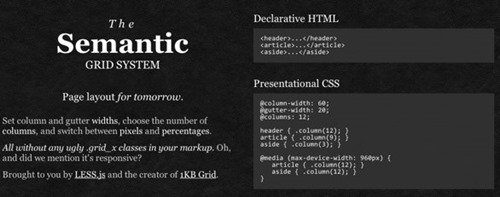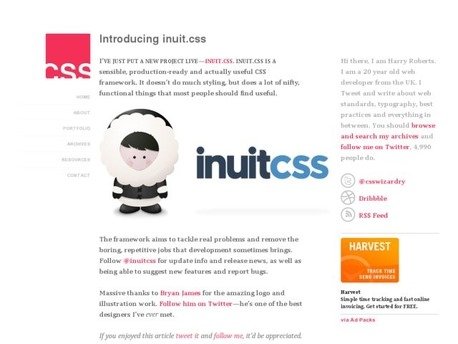
There is a set of techniques that is used in web development to make to make sure that the images and layout of a website are flexible. This is known as responsive web design. These techniques allow websites to adapt to the different browser window screen sizes of different users. This is done by using fluid dimensions while creating the website.
We live in a world where people do not only access the internet through computers but through smart phones and other handheld devices. This is why responsive web design and the tools that are used for it are so important. There are a number responsive design tools that web designers use. Let us take a look at the top 7 tools in brief:
Less Framework 4
This happens to be a system that is used to design adaptive or responsive websites.. The goal of this system is to make sure that web developers are able to create and develop websites more efficiently. Layouts are also more consistent when Less Framework 4 is used. Other than this the evolution of multiple layouts can also be created.
Semantic Grid System
With this system, the column and gutter widths can be more easily specified. You can also gutter the number of columns as variables that are at the top of LESS files. Another great benefit to using the Semantic Grid System is that resolutions can be altered using by using the media queries from CSS3. The system supports all browsers including Internet Explorer 6 and above as well.
Golden Grid System
The Golden Grid System is another web grid system. It is a CSS tool for websites that are grid- based. It is the result of the hunt for a grid system that is modern. The GGS divides the screen into eighteen columns that are all even. The outermost columns are used as margins and the remaining sixteen columns are available for use in the design of a website. It enables the website to dish out pages that look great and range from 240 to 2560 pixels.
320 And Up
This is a responsive boilerplate that uses CSS media queries. It is a starting template that is used for the development of responsive web pages that are modern. It uses an approach that is very different from what other existing boilerplates use. It uses a style sheet that tiny screens use as a starting point. This prevents mobiles from downloading assets that are meant for desktop computers.
Skeleton
 The Skeleton CSS Boilerplate is a set of CSS files. It helps web developers in creating websites that are responsive to screens of all sizes. It provides a fast and easy way to develop such sites. One of the best features of this boilerplate is the fact that is so easy to use and it provides web designers the power to start the development from scratch.
The Skeleton CSS Boilerplate is a set of CSS files. It helps web developers in creating websites that are responsive to screens of all sizes. It provides a fast and easy way to develop such sites. One of the best features of this boilerplate is the fact that is so easy to use and it provides web designers the power to start the development from scratch.
Inuit.Css
This is a CSS framework that is so easy to use that even beginners can use to develop their web pages. It is very versatile as it can work with the basic things that are necessary to develop a site and at the same time, an extension can be done with plug-ins that are available so that more can be done with the site. There are a number of ways that it can be used to come up with creative and cool web pages. The fact that it is responsive is probably one of its coolest features. Columns are all stacked vertically so that they fill horizontal space that remains if a browser is less than 720 pixels wide.
Gridless
This is a LESS-based grid framework that is used for web content. CSS files are generated so that web developers can focus on the design rather than revising the never-ending declarations of style. It separates the structure of documents and visual presentation completely and provides flexibility by using the progressive character of LESS. Gridless makes web designing less boring as its package includes everything that developers hate about a new project. It has CSS normalization, a well-organized structure for folders, fixes for IE bugs, etc.
People who need websites are now putting more consideration into getting a responsive website design. The fact is that this is an era of digital media and people are using more than just laptops and desktops to connect to the internet. Mobile phones are one of the most used devices for internet connectivity nowadays. Businesses realize this and the fact that they can connect to a wider target audience if their websites are compatible with small devices like mobiles, etc. as well as larger ones.
With the help of the tools mentioned above, web developers are able to provide their clients with web pages that can be accessed from any type of device, no matter what size their screens are. This is beneficial for any company or business as they are able to connect with their audience anywhere, anytime. It helps users to check out various sites without having to use a PC. This is great as they are able to connect to any web page while they are on the go.
There are businesses that are not too sure about what they are looking for in a webpage. If they have any doubts or questions, they can ask their web developers and get the answers that they need. For example, are responsive websites more beneficial to the company? In what exactly can they benefit from it? There are many aspects to owning a website and businesses need to make sure that they are clear on every one of them so that they can get optimum traffic and eventually, profit. Responsive web designs can definitely help businesses. Not only do they benefit companies but users as well, as they are now more in touch with their favorite sites, etc. As more people use hand-held devices to log on to the web, the use of responsive design tools grows.
This is a guest post by Rajkumar who is the founder of TechnoWooer and Technoford. Visit his blog to know more. You can join him on Twitter@jonnalarajkumar
RELATED POSTS
View all






